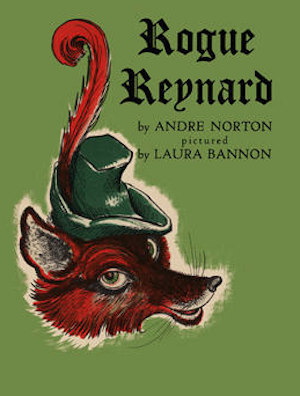Rogue Reynard is a real oddity in the Andre Norton canon. It was first published in 1947, then re-published in 1972 as a Dell Yearling Book. This series, according to the notes in the front matter, consists of works “designed to entertain and enlighten young people,” selected by a pair of learned professors.
It reads exactly like that. It is so earnest and so punctilious and so edifying. It’s a solid, or should I say stolid, example of the mock-medieval beast fable, complete with pretentious chapter headings—Chapter the first. Which telleth how King Lion kept Court and Baron Reynard appeared not thereat—and yea-verily prose. There’s funky capitalization and, in the Yearling edition I tracked down to a children’s bookstore in England, fancy Gothic title fonts.
The story has the somewhat rambling structure of a medieval fable. King Lion holds court, Baron Reynard fails to show, the king sends a succession of lackeys to bring him in. The wicked baron outwits every one, humiliates and sometimes murders them, until finally the lowly Squire Hound proves to be his match.
We often forget how dark children’s stories could be, back in the day. Rogue Reynard has an actual body count, and the ones he doesn’t kill and hang up in the larder are usually tricked into invading the realms of Man and being beaten half to death for it. Everybody is either stupid or wicked, and most of the characters are both.
The child reader, one presumes, is meant to Learn Lessons from the story. Always obey authority, never lie or cheat or steal, and go easy on the murder as well. You might get away with it for a considerable while, but you’ll always get caught in the end.
I am not the intended audience for this book. I have always hated talking animals. A good part of that is a childhood with hearing problems and no closed captioning or other forms of accessibility, which made watching cartoons a frustrating and frequently incomprehensible experience. Then there’s the recurring nightmare in which instead of real animals, I was afflicted with lifeless toys, stick horses and stuffed bunnies.
When I grew up I became a medievalist, with the degrees and everything. I read a fair sampling of beast fables. Didn’t like them any better as an adult than as a child. I could appreciate the craft of the works, but they didn’t do anything for me.
Buy the Book


A Spindle Splintered
Norton certainly gave it her all, and clearly the good professors thought she succeeded. For me, the story was lifeless and heartless and devoid of either wit or charm. With a title like Rogue Reynard, I expected more of the fox than a series of Big Lies and Mob-style hits. I was cheering his enemies on by the second chapter, and by the end was quite tired of waiting for him to get what he deserved.
Even at that, I didn’t think the ending was very satisfying. Reynard’s head in a bag was the least I might have expected. After all, he did it to one of the king’s emissaries.
As far as stupid King Lion and venal courtiers and underhanded tricks go, I personally prefer the cartoon lion king in Bedknobs and Broomsticks. That isn’t nearly as mean-spirited, and it has actual wit, though the humor can be a little broad. It’s much more deftly done, and much more honestly entertaining.
I have to say however that the consistent stupidity of the king and his flunkies, and the lying, cheating, and downright malicious ill doings of the fox and his friends, felt weirdly topical. The fox doesn’t just cheat and lie, he goes for the Big Lie. He’s out to be king himself, and he goes about it in the most underhanded way possible. One would almost think Norton foresaw the direction our politics would take after the turn of the millennium.
This is one of those books that ticks the completist box, but it’s an outlier in the wider picture of Norton themes and styles and genres. Norton had a strong earnest streak and often wrote worlds and characters without empathy or compassion. This kicks it up a few notches. I caught myself thinking that a particularly wicked child would treat it as a manual rather than a cautionary tale: take the fox as a role model instead of a villain to be defeated and destroyed.
The best thing I can say is that I’ve read it. I can move on. Up next: Seven Spells to Sunday.
Judith Tarr has written historicals and historical fantasies and epic fantasies and space operas, many of which have been published as ebooks. She has won the Crawford Award, and been a finalist for the World Fantasy Award and the Locus Award. She lives in Arizona with an assortment of cats, a blue-eyed dog, and a herd of Lipizzan horses.










